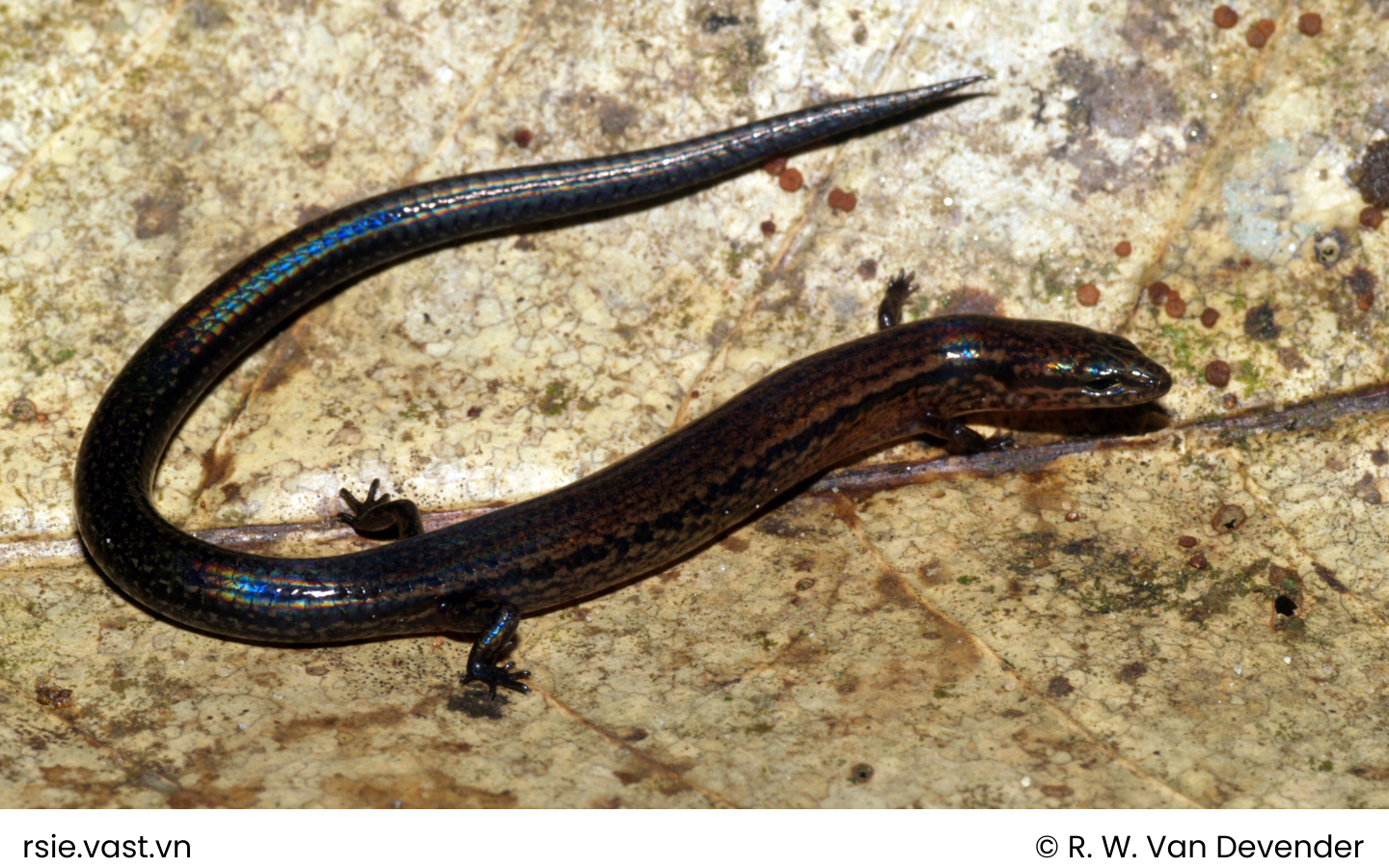
Science name: Sphenomorphus sheai – Nguyen, Nguyen, Van Devender, Bonkowski & Ziegler, 2013
Taxonomic: Animalia>> Chordata>> Reptilia>> Squamata >> Scincidae >> sheai
Species status: Endemic ; IUCN status: LC (Least Concern)
Description:
Physical Characteristics:
Size: Small skink with a snout-vent length (SVL) of 35.2 mm.
Scales: It has four supraoculars, six supralabials (the first of which is fused with the nasal), and two primary temporals. Its midbody scales are arranged in 20 rows, and the paravertebral scales number 53 and are not widened.
External Features: Notably, this species lacks external ear openings. The lower eyelid is scaly, and there are no white edges along the margins of the upper and lower eyelids. The limbs are short and pentadactyl, with six lamellae under the fourth toe.
Coloration and Appearance:
The dorsum and tail base of Sphenomorphus sheai are bronze-brown, marked with dark dots. A light dorsolateral stripe is present on the neck, shoulder, and the anterior part of the dorsum. A narrow black stripe runs along the upper lateral part of the head and flank, contributing to its distinct appearance.
Distribution and habitat:
Elevation:
The type locality of Sphenomorphus sheai is recorded at an elevation of 1,025 meters above sea level in the Kon Tum Plateau, a region located in the border area between Quang Ngai and Kon Tum provinces in southern Central Vietnam.
Area:
This species is currently only known from the Kon Tum Plateau in southern Central Vietnam. It inhabits the area between Quang Ngai and Kon Tum provinces, specifically in secondary forests near streams.
Habitat:
Sphenomorphus sheai was found in secondary forest. The holotype was collected at night, approximately two hours after dark, on a steep slope above a small stream. This species appears to be associated with leaf litter and forest floors, where it was found at about three meters above the stream. The forest type is montane subtropical/tropical moist, providing suitable conditions for this species.
Behaviour and ecology:
Lifestyle:
Sphenomorphus sheai is a nocturnal, ground-dwelling skink, found active in the leaf litter of secondary forests. The holotype was discovered at night, foraging or moving among the leaf litter on a steep slope above a stream. Its association with forested, moist environments suggests it is well-adapted to life in montane forest ecosystems.
Reproduction:
The species is oviparous. The holotype contained four small white follicles in each ovary, indicating that females likely produce small clutches of eggs.
Conservation and status:
IUCN Red List Category and Criteria:
Sphenomorphus sheai is listed as Data Deficient on the IUCN Red List, as only the holotype has been recorded, and there is insufficient data on its population, distribution, and ecological requirements. The most recent assessment was conducted in 2017.
Population Trend:
The population trend for Sphenomorphus sheai is currently unknown, as there is no available information on population size or stability.
Threats:
Although specific threats to this species have not been identified, habitat degradation and deforestation could pose risks, particularly since the species is found in secondary forests. Continued habitat loss in the Kon Tum Plateau region could threaten its survival.
Conservation Actions:
No specific conservation measures are in place for Sphenomorphus sheai, although it may benefit from general efforts to protect the Kon Tum Plateau and surrounding forested areas. Further research is needed to better understand its distribution, population size, and ecological requirements.
Etymology
The species name sheai honors Dr. Glenn Shea from the University of Sydney, Australia, for his outstanding contributions to the systematics of scincid lizards.
Crocodile Trail – The Best Birding Trail in Cat Tien National Park
If you’re a birder or nature photographer planning a trip to Vietnam, few places offer [...]
Cong Troi Trail – Top 1 Dalat Plateau Birding Trail Experience
If you’re a birder or nature photographer planning a trip to Vietnam’s Central Highlands, the [...]
How to Identify the Greater Sand Plover, Tibetan Sand Plover and Siberian Sand Plover
Identification Differences within the Sand Plover Complex: The sand plover group, which was traditionally divided [...]
Highlights of Cat Tien National Park Reptiles and Amphibian Endemics
Spanning over 71,350 hectares of tropical forests, grasslands, and wetlands, Cat Tien National Park is [...]
Highlights of Cat Tien National Park Mammals in a World Biosphere Reserve
In addition to reptiles and birds, Cat Tien National Park is also rich in mammals, [...]
Kontum Plateau Endemic and Highlight bird
Kontum Plateau Endemic And Highlight Bird species like Chestnut-eared Laughingthrush and top birding routes while [...]